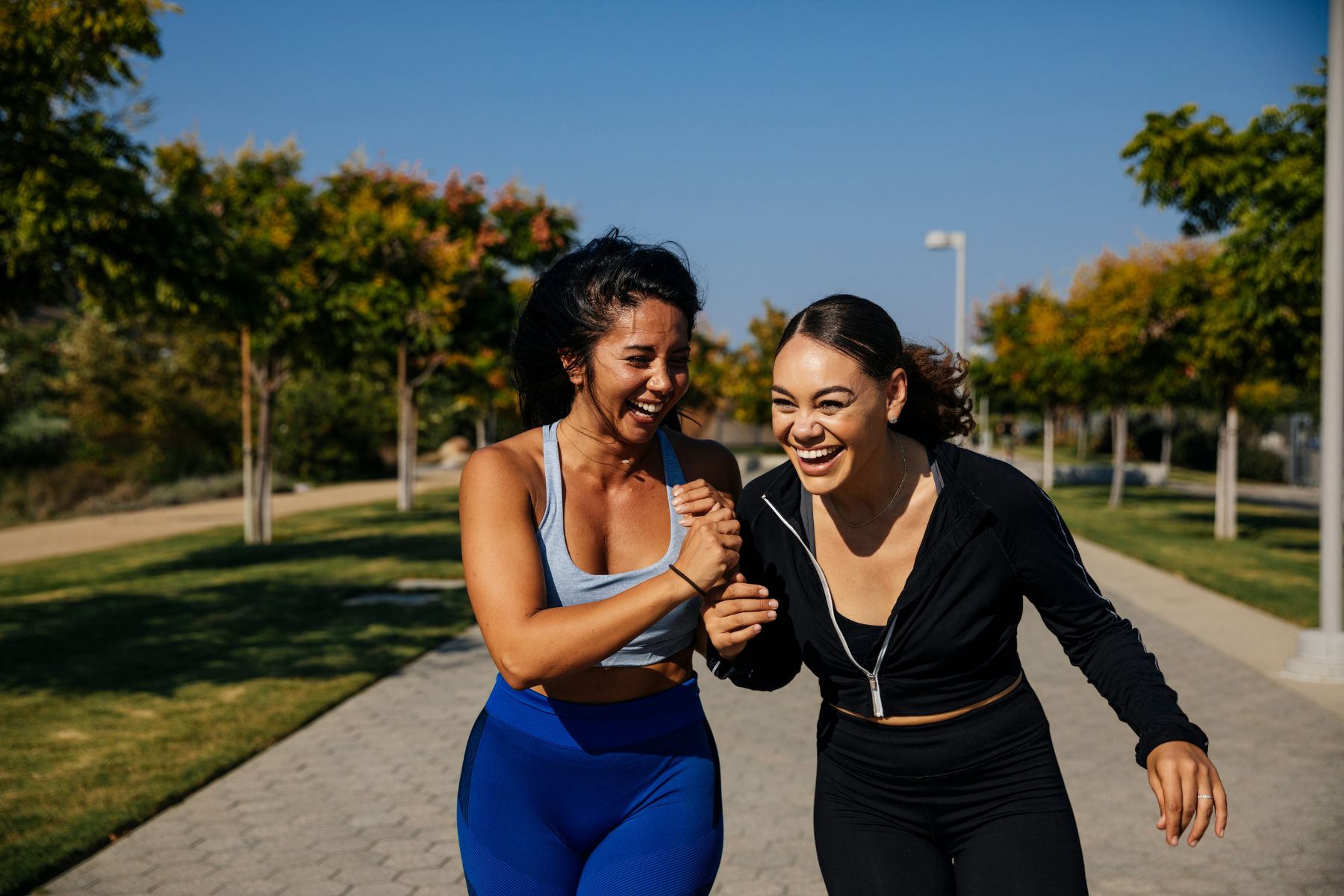
The Good Brigade / DigitalVision via Getty Images
6 Ways Breaking a Sweat Can Boost Your Social Life
Working out can boost your confidence, reduce anxiety, and help you connect with fellow exercisers. Here’s how to maximize both your reps and your relationships.
By Greg Presto•
6 Social Benefits of Exercise
Can Any Type of Workout Provide These Social Benefits of Exercise?
How Long Will It Take to Notice These Social Benefits of Exercise?
Tap Into the Social Benefits of Exercise with Peloton
The physical and mental benefits of working out are well known, but there’s another way regular exercise may improve your health: It can strengthen your sense of community. In turn, that can make it easier to maintain existing friendships, make new ones, and reduce loneliness.
Discover more ways to reach your goals with Peloton
Why? Well, we’ve evolved to be together. And we’ve evolved to move. Which is why there aren’t just physical benefits, but social benefits of exercise, says Arran Davis, PhD, a postdoctoral researcher at the Centre for the Study of Social Cohesion at the University of Oxford.
Our ancestors evolved to forage and hunt together, he says, so our brains reward us when we’re physically active, especially when moving together. Exercising together gives us a way to collaborate, he says, which makes us connect. It also releases endorphins and endocannabinoids (some animal research suggests that the latter may be the chemical responsible for the famous “runner’s high”) that we feel simultaneously, which makes us like each other.
But the social benefits of fitness aren’t just tied to building stronger friendships, says Julianne Holt-Lunstad, PhD, a professor of psychology and neuroscience at Brigham Young University. Her research has found that being with others improves cognitive abilities as well as cardiovascular and immune function.
“People tend to separate the social benefit as only being good for our emotional wellbeing. But the social aspect itself is good for cardiovascular outcomes,” she explains, citing her research linking loneliness to increased risks of cardiovascular disease, reduced immune function, and lowered cognition. The compound effect of this could lead to a 50 percent increased odds of survival, she adds.
While exercising with others likely won’t completely offset that risk, it may reduce loneliness—and as Holt-Lunstad’s research above suggests, having strong social connections can benefit everything from your brain health to your heart health.
6 Social Benefits of Exercise
Combating loneliness isn’t the only surprising social benefit you’ll gain from regular exercise. Here are six more, plus insights from experts on how you can reap these social benefits of fitness in your next workout.
1. Exercise Can Create a Social Domino Effect, Making You More Social Overall
When we’re lonely and need social connection the most, we’re less likely to seek it out and give ourselves what we need, according to a 2023 study done by Natalie Pennington, PhD, an assistant professor of communication studies at Colorado State University who researches friendship. Conversely, when we have more social connection, we’re more likely to get more of it, maintaining “high belongingness” levels.
It’s almost like we’ve got social muscles, Pennington says. Like our skeletal muscles, they need to be warmed up and can be strengthened. Group exercise is an easy, accessible way to “stretch those social muscles,” she says. Once you’re in social motion, you’re likely to stay that way. “The more comfortable we are already doing the [socialization], the easier it is to keep it going.”
Research shows this social domino effect is real. In a 2022 study, researchers had study participants go on a weeklong scavenger hunt where they had to practice being sociable by starting short conversations with strangers. Not only did participants feel better about their conversational ability, but the effects lasted for a week after the study ended.
2. Exercise Can Help Strengthen Your Current Friendships
When our close friends are far away, we may lose touch not just because we aren’t seeing each other as regularly, but because we don’t know what to talk about. Exercise—or any other activity that you and friends decide to do together—can grease the wheels of conversation and keep you in touch, Pennington says, because you’ve got something specific to talk about.
Creating a group text that’s your own virtual “running club,” joining a Peloton challenge together, or planning to train and meet for a race or other competition can be “a way to maintain relationships that are at a distance and might otherwise diminish,” Holt-Lunstad says.
Texting or virtual interaction alone doesn’t fill all of our relationship needs, according to research by Pennington. But they can help facilitate an in-person activity, such as a yoga retreat or hiking trip, and that’s valuable. “These get togethers … probably wouldn’t happen at all without that [digital interaction],” Holt-Lunstad says.
3. Exercise Can Create Casual “Activity Friendships”
Relationships with our BFFs are important, but acquaintances matter too. When you see your barista each morning or wave hello to a neighbor each evening, you’re getting social benefit from what scientists call “weak ties.” Studies have shown that when we interact with more weak ties, we experience more feelings of belonging and overall better subjective feelings of wellbeing.
“We might see each other with some degree of regularity, but we don’t share or disclose things outside of that context,” Pennington says. “You get that social connection, which can boost your daily mood, but you also don’t have the same degree of obligation” that you do with closer friends.
Group exercise is an easy way to increase weak ties, or what Pennington calls “activity friends.” Attending a class at the same time each week or playing in the same pickup game, for example, can help us run into the same people again and again.
4. Exercise Can Help You with Commitment
Scientists have found that people who participate in group exercise significantly increase the amount of activity they do each week. Those feelings of social support are one of the most important factors in sticking to exercise long-term. This could be because feeling like you’re part of a group is one of the main psychological needs that motivate us.
This works with digital connection too, Pennington says. In a study she conducted on wearable technology, like fitness watches, she found that when users connected with other watch-wearers, they were more accountable and used the watch more often. This aligned with another 2022 study that found that users on a running platform who connected with more friends engaged in more exercise.
One potential pitfall: People can get competitive, and that can turn some would-be friends and exercisers off. The solution, Davis says, is to find friendship fitness goals that are cooperative. Banding together to bike a certain number of miles over the course of a month, or attending a certain number of classes together over a year, gives the group something to strive for as a unit, which can create stronger bonds, he says.
Peloton’s teams feature makes it easy to do just that by allowing you to create your own team with friends or family and work together toward a shared goal or milestone.
5. Exercise Can Reduce Social Anxiety
Regular exercise can reduce anxiety by releasing feel-good chemicals like endorphins and endocannabinoids, which are amplified when we move with others. This can bond us to the people we’re experiencing them with, Davis says.
But even when done alone, exercise makes us more open to others. In a 2017 study published in the Journal of Sports Economics, people who exercised by themselves for 30 minutes were twice as trusting and generous in an economic game they played after the workout than another group that didn’t exercise.
Physical activity also reduces stress levels and improves our view of ourselves. In one study of 300 adults aged 20–60, those who reported performing more physical activity had higher levels of self-esteem.
“When my self-esteem is boosted, I’m going to have better daily wellbeing, better life satisfaction, which then, in turn, allows me to connect,” says Pennington.
6. Exercise Optimizes Your Body to Boost Performance
When you exercise with others, you perform better. And it’s not just thanks to greater motivation. When we’re alone, Davis says, our bodies sense danger—just like if we were alone in the woods. When our bodies sense danger, they conserve energy by making us feel fatigued faster, among other things. But when we’re with others, or what’s called a “social support condition,” fatigue comes on less quickly, meaning we can work out stronger for longer.
“It’s like the body’s being less cautious,” he says. “It makes sense. If your body is getting these cues of social support, then it can ease off the brake,” letting you give a more all-out effort.
Can Any Type of Workout Provide These Social Benefits of Exercise?
Some of these social benefits of exercise can be accomplished even if your workout itself isn’t social: Solitary exercise is associated with reduced stress, increased self-esteem, and less anxiety, all of which promote better wellbeing.
Other social benefits of exercise require a group. Some have only been shown to be effective in person. But online interactions can be helpful too, Pennington says. Joining an online group, where you interact with others can increase accountability, as it has in previous studies, and can also be a way to practice interacting with “weak ties.”
“You can have some degree of anonymity while still getting support from other people online with some degree of consistency,” she says. “This could be really good for us, because support tends to help us move forward in our goals.”
How Long Will It Take to Notice These Social Benefits of Exercise?
You’ll feel some of these social benefits of exercise immediately, Holt-Lunstad says: When endorphins are released from exercise, they boost our moods right away. And having a loved one next to you during a tough workout also helps instantly: As part of a study some 10 years ago, she observed that during a stressful task, having a supportive friend nearby reduced blood pressure compared to undergoing that stress without support.
But to experience lasting changes, she says, the social benefits of exercise are kind of like exercise: You need to do it consistently to see results.
“In essence, it takes time to build relationships … you’re not going to just instantly be best friends with someone the first time you meet them,” she says. But the consistency of an exercise regimen can offer opportunities to see the same people and bond.
Tap Into the Social Benefits of Exercise with Peloton
Even when you’re working out at home, you can still be social. Peloton makes it easy to connect with old and new friends to reap these social benefits—and have fun doing it.
With Peloton teams, you can build or join a group of fellow Peloton Members to offer each other support and work together towards cumulative goals. Your team can join challenges to work together: Choose a challenge based on the number of workouts, number of days exercising, amount of time spent working out, or distance traveled. Each team member’s progress will be displayed on the team Leaderboard, and you can cheer each other within your team’s Feed tab.
You can even join a team if none of your current friends or family are Peloton Members: Select “Discover” in the Teams area of the Community section of the Peloton App, and you’ll be able to search for teams that match your interests, as well as seeing featured teams that match your profile.

Peloton App
Access thousands of classes with no equipment needed.
This content is for informational and educational purposes only and does not constitute individualized advice. It is not intended to replace professional medical evaluation, diagnosis, or treatment. Seek the advice of your physician for questions you may have regarding your health or a medical condition. If you are having a medical emergency, call your physician or 911 immediately.
Strengthen your mind-body connection
Enter your email to get articles, expert-backed tips, and updates from Peloton sent to your inbox.
By providing your email address, you agree to receive marketing communications from Peloton.
For more about how we use your information, see our Privacy Policy.












